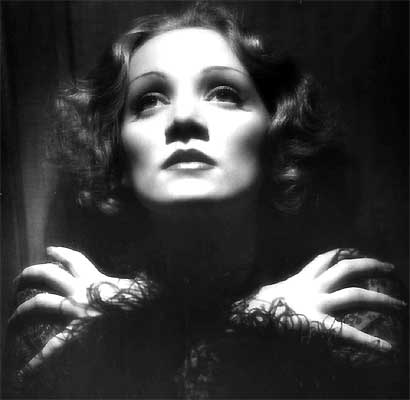
beautyme collections culture cuisine motor music search
 Marlene
Dietrich, creation of a myth
Marlene
Dietrich, creation of a myth
Musée
Galliera
14 June – 12 October 2003
fig.: Marlene
Dietrich
in Shangaï Express, 1931
Photo: Eugene Robert Richee ©: Filmmuseum Berlin - MDC
This is the first time in France that a major exhibition has been devoted to Marlene Dietrich (1901-1992). Mounted by the Musée Galliera, the exhibition has been organised in association with the Berlin Filmmuseum, home of the Marlene Dietrich collection.
Over 250 items will be on show, either individually or grouped to form portraits in silhouette. All these clothes and accessories were worn by the star between the 1930s and the 1970s, on screen, in her stage shows and in her private life. Filled out with original photographs and projected stills from her films, this revealing presentation is structured around a comparison of her two wardrobes – the private and the professional – with the latter mainly covered by photographs.
With this exhibition the Musée Galliera sets out to celebrate Marlene Dietrich's unique elegance – so often imitated but never equalled – while spotlighting the culture of appearance that she brought to its apogee. She spent her life creating a personal myth, meticulously honing it day by day after beginning with the invention of her own first name : Marlene was in fact a contraction of Marie Magdalene.
To mark the presentation of this tribute to a great star in its Museum of Fashion, the City of Paris will be renaming a square in the 16th arrondissement after her. A regular client of the great fashion designers, Marlene Dietrich loved visiting Paris, making the city her home for the last seventeen years of her life.
A relentless worker whose demands knew no limits, she expertly got her directors to do things her way, supervising the design of her clothes down to the last detail and inventing a personal makeup style to highlight the strong points of her face. Like a director of photography, she monitored her image at every moment, using a mirror to ensure that the movie or still camera brought her across exactly as she wanted.
The rigorously cultivated absence of any distinction between her professional and everyday personae gave rise to a fertile but complex dialogue between her screen roles and the image projected in her private life. Sometimes she added the final touch to a screen costume with an article from her own wardrobe ; or simply borrowed her film clothes to go out in. One of the exhibition's aims, then, is to point up this commingling of public and private, this layering of images whose fundamental vector was clothing.
Credit for the initial appearance of the persona must go to the cinema and Joseph von Sternberg. In the seven films he made with Dietrich in 1929-35, the director created an icily erotic female figure, enveloped in mystery and presenting the face and overall appearance of three archetypes : the unfettered young woman, the androgyne and, at the opposite extreme, the femme fatale.
Sternberg's genius lay in the way he brought out the masculine-feminine ambiguity embodied by "Mr and Miss Marlene". Throughout her career she would play on this ambivalence, living it out for in her own life and dramatising it on the screen. As times and standards changed, however, this duality gradually lost its outrageousness.
Later, under the influence of new directors like Ernst Lubitsch and Joe Pasternak, photographers like Edward Steichen, Cecil Beaton and Horst P. Horst, and the American way of life – she took out citizenship in 1937 – the image moved towards something more feminine.
During 1944-45 Dietrich made an active contribution to the war effort, touring as a singer in GI camps sometimes close to the front line. This experience led to a major shift in her career and in 1953 she gave up films for the stage, retiring only reluctantly in 1975 after accidentally breaking a leg. In the meantime she made appearances all over the world, performing several times in Paris, notably at the Olympia in May 1962.
In the course of this long movie and stage career, she worked with Hollywood's top costume designers, including Travis Banton, Jean Louis and Irene. Her personal wardrobe came from men's tailor Knize, Schiaparelli, Dior, Chanel and other leading couturiers. Yet while they all played their part in making her a major fashion figure, the star was far from a mere clothes horse. No slave to the transitory and the modish, she never strayed from her characteristic mix of the relaxed and the sophisticated – the incomparable "Marlene Dietrich style".